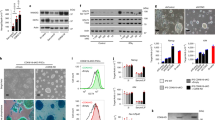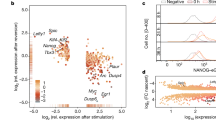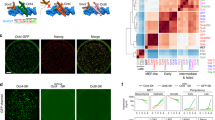Abstract
Embryonic stem (ES) cells are pluripotent cells derived from the inner cell mass of blastocysts. Self-renewal of mouse ES cells depends on activation of Stat3 by leukaemia inhibitory factor (LIF) in collaboration with bone morphogenetic protein signalling1,2,3. The transcription factor Nanog is essential in maintaining pluripotency4,5 but the mechanisms involved are poorly understood. Here we examine the functional interactions of Nanog with the Stat3 and NFκB pathways. Nanog and Stat3 were found to bind to and synergistically activate Stat3-dependent promoters. We also found that Nanog binds to NFκB proteins; however, Nanog binding inhibited transcriptional activity of NFκB proteins. Endogenous NFκB activity and target-gene expression increased during differentiation of ES cells. Overexpression of NFκB proteins promoted differentiation, whereas inhibition of NFκB signalling, either by genetic ablation of the Ikbkg gene or overexpression of the IκBα super-repressor, increased expression of pluripotency markers. We conclude that Nanog represses the pro-differentiation activities of NFκB and cooperates with Stat3 to maintain pluripotency.
This is a preview of subscription content, access via your institution
Access options
Subscribe to this journal
Receive 12 print issues and online access
$209.00 per year
only $17.42 per issue
Buy this article
- Purchase on Springer Link
- Instant access to full article PDF
Prices may be subject to local taxes which are calculated during checkout




Similar content being viewed by others
Accession codes
References
Smith, A. G. Embryo-derived stem cells: of mice and men. Annu. Rev. Cell Dev. Biol. 17, 435–462 (2001).
Boiani, M. & Scholer, H. R. Regulatory networks in embryo-derived pluripotent stem cells. Nature Rev. Mol. Cell Biol. 6, 872–884 (2005).
Boyer L. A., Mathur, D. & Jaenisch, R. Molecular control of pluripotency. Curr. Opin. Genet. Dev. 16, 455–462 (2006).
Chambers, I. et al. Functional expression cloning of Nanog, a pluripotency sustaining factor in embryonic stem cells. Cell 113, 643–655 (2003).
Mitsui, K. et al. The homeoprotein Nanog is required for maintenance of pluripotency in mouse epiblast and ES cells. Cell 113, 631–642 (2003).
Hayden, M. S. & Ghosh, S. Signaling to NFκB. Genes Dev. 18, 2195–2224 (2004).
Perkins N. D. Integrating cell-signalling pathways with NFκB and IKK function. Nature Rev. Mol. Cell Biol. 8, 49–62 (2007).
Pan, G. & Pei, D. The stem cell pluripotency factor NANOG activates transcription with two unusually potent subdomains at its C terminus. J. Biol. Chem. 280, 1401–1407 (2005).
Suzuki, A. et al. Nanog binds to Smad1 and blocks bone morphogenetic protein-induced differentiation of embryonic stem cells. Proc. Natl Acad. Sci. USA 103, 10294–10299 (2006).
Levy, D. E. & Darnell, J. E. Jr Stats: transcriptional control and biological impact. Nature Rev. Mol. Cell Biol. 3, 651–662 (2002).
Jones, F. S. et al. Barx2, a new homeobox gene of the Bar class, is expressed in neural and craniofacial structures during development. Proc. Natl Acad. Sci. USA. 94, 2632–2637 (1997).
Loh, Y. H. et al. The Oct4 and Nanog transcription network regulates pluripotency in mouse embryonic stem cells. Nature Genet. 38, 431–440 (2006).
Kasahara, H. et al. Characterization of homo- and heterodimerization of cardiac Csx/Nkx2.5 homeoprotein. J. Biol. Chem. 276, 4570–4580 (2001).
Wang, J. et al. A protein interaction network for pluripotency of embryonic stem cells. Nature 444, 364–368 (2006).
Kim S., La Motte-Mohs R. N., Rudolph D., Zuniga-Pflucker J. C. & Mak T. W. The role of nuclear factor-kappaB essential modulator (NEMO) in B cell development and survival. Proc. Natl Acad. Sci. USA 100, 1203–1208 (2003).
Boyer, L. A. et al. Polycomb complexes repress developmental regulators in murine embryonic stem cells. Nature 441, 349–353 (2006).
Boyer, L. A. et al. Core transcriptional regulatory circuitry in human embryonic stem cells. Cell 122, 947–956 (2005).
Silva, J., Chambers, I., Pollard, S. & Smith, A. Nanog promotes transfer of pluripotency after cell fusion. Nature 441, 997–1001 (2006).
Merika, M. & Thanos, D. Enhanceosomes. Curr. Opin. Genet. Dev. 11, 205–208 (2001).
Lerner, L., Henriksen, M. A., Zhang X. & Darnell, J. E. Jr STAT3-dependent enhanceosome assembly and disassembly: synergy with GR for full transcriptional increase of the α 2-macroglobulin gene. Genes Dev. 17, 2564–2577 (2003).
Magness, S. T. et al. In vivo pattern of lipopolysaccharide and anti-CD3-induced NFκ B activation using a novel gene-targeted enhanced GFP reporter gene mouse. J. Immunol. 173, 1561–1570 (2004).
Narayanan, R., Higgins, K. A., Perez, J. R., Coleman, T. A. & Rosen, C. A. Evidence for differential functions of the p50 and p65 subunits of NFκB with a cell adhesion model. Mol. Cell. Biol. 13, 3802–3810 (1993).
Armstrong, L. et al. The role of PI3K/AKT, MAPK/ERK and NFκB signalling in the maintenance of human embryonic stem cell pluripotency and viability highlighted by transcriptional profiling and functional analysis. Hum. Mol. Genet. 15, 1894–1913 (2006).
Brons, I. G. et al. Derivation of pluripotent epiblast stem cells from mammalian embryos. Nature 448, 191–195 (2007).
Tesar, P.J. et al. New cell lines from mouse epiblast share defining features with human embryonic stem cells. Nature 448, 196–199 (2007).
Bendall, S. C. et al. IGF and FGF cooperatively establish the regulatory stem cell niche of pluripotent human cells in vitro. Nature 448, 1015–1021 (2007).
Emre, N., Coleman, R. & Ding, S. A chemical approach to stem cell biology. Curr. Opin. Chem. Biol. 11, 252–258.
Ezeh, U. I., Turek, P. J., Reijo, R. A. & Clark, A. T. Human embryonic stem cell genes OCT4, NANOG, STELLAR, and GDF3 are expressed in both seminoma and breast carcinoma. Cancer 104, 2255–2265 (2005).
Skotheim, R. I. et al. Differentiation of human embryonal carcinomas in vitro and in vivo reveals expression profiles relevant to normal development. Cancer Res. 65, 5588–5598 (2005).
Acknowledgements
We thank T. W. Mak, M. Gassmann, A. Smith, I. Chambers, T. Hirano, T. Fukada, F. Ventura, T. López-Rovira, I. Kerr, J. C. Lacall and S. Aznar-Benith for sharing reagents, Lisa Sevilla for helpful discussions and Héctor Pálmer for advice about transcriptional assays. We are indebted to Lola Martínez and Phil East from the London Research Institute, Cancer Research UK (CRUK) for their help with the flow cytometric and ChIP analyses. This work was supported by CRUK, the Wellcome Trust and EuroStemCell. J.T. was the recipient of a FEBS postdoctoral fellowship.
Author information
Authors and Affiliations
Contributions
J. T. carried out the exerimental work, J. T. and F. M. W. contributed to the project planning, data analysis and writing of the manuscript.
Corresponding author
Supplementary information
Supplementary Information
Supplementary figures S1, S2, S3, Supplementary table S1 (PDF 310 kb)
Rights and permissions
About this article
Cite this article
Torres, J., Watt, F. Nanog maintains pluripotency of mouse embryonic stem cells by inhibiting NFκB and cooperating with Stat3. Nat Cell Biol 10, 194–201 (2008). https://doi.org/10.1038/ncb1680
Received:
Accepted:
Published:
Issue Date:
DOI: https://doi.org/10.1038/ncb1680
This article is cited by
-
BET proteins are essential for the specification and maintenance of the epiblast lineage in mouse preimplantation embryos
BMC Biology (2022)
-
The role of the TGF-β/LIF signaling pathway mediated by SMADs during the cyst formation of Echinococcus in young children
BMC Molecular and Cell Biology (2022)
-
c-MYC Triggers Lipid Remodelling During Early Somatic Cell Reprogramming to Pluripotency
Stem Cell Reviews and Reports (2021)
-
A cytokine screen using CRISPR-Cas9 knock-in reporter pig iPS cells reveals that Activin A regulates NANOG
Stem Cell Research & Therapy (2020)
-
Coordinated regulation of Rel expression by MAP3K4, CBP, and HDAC6 controls phenotypic switching
Communications Biology (2020)



